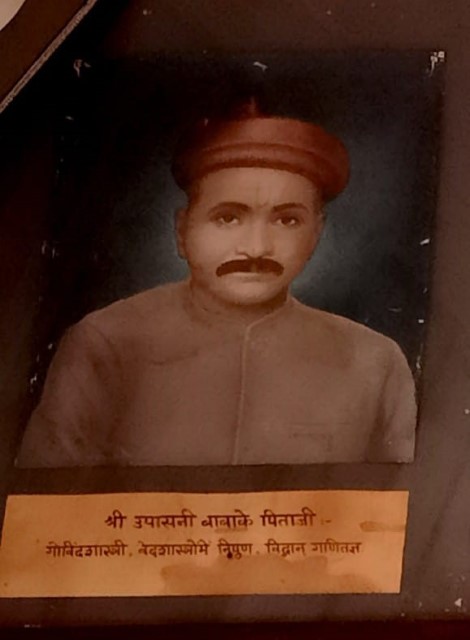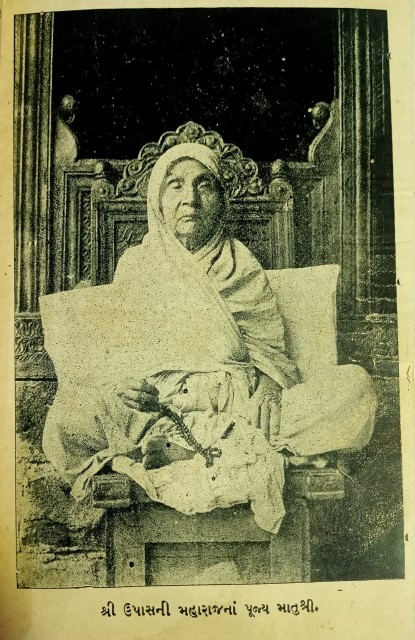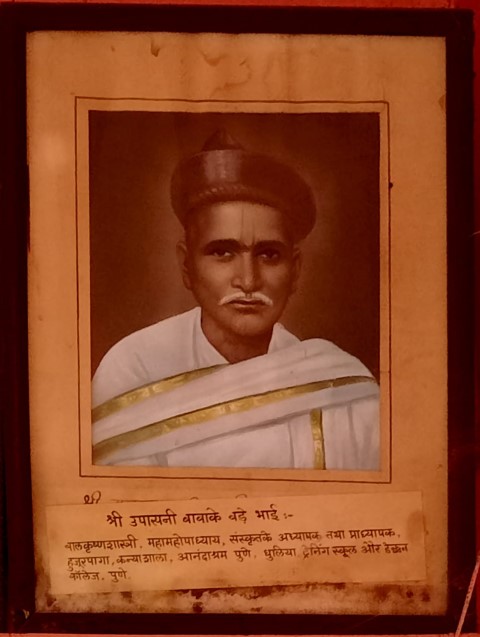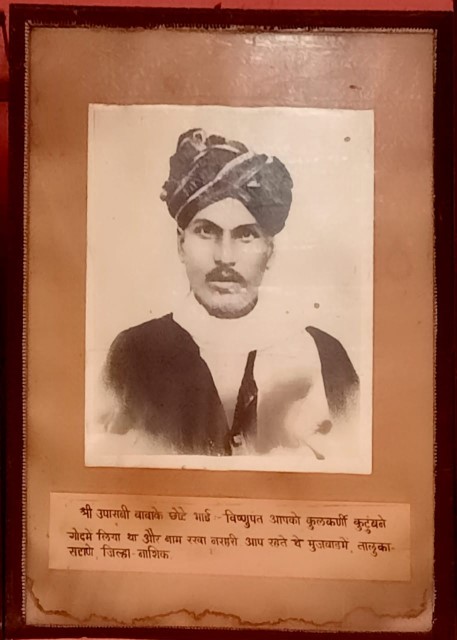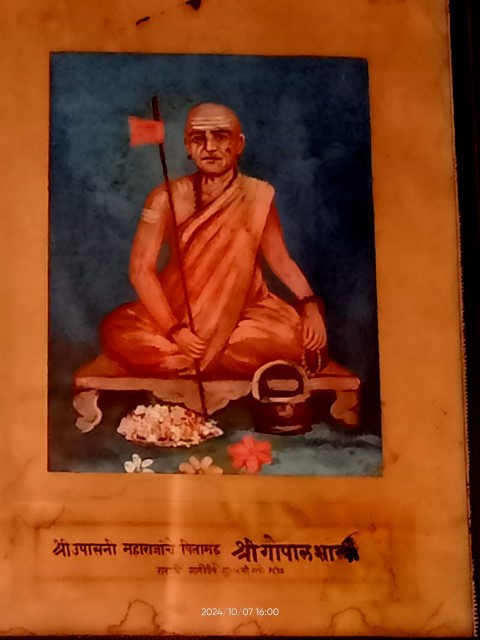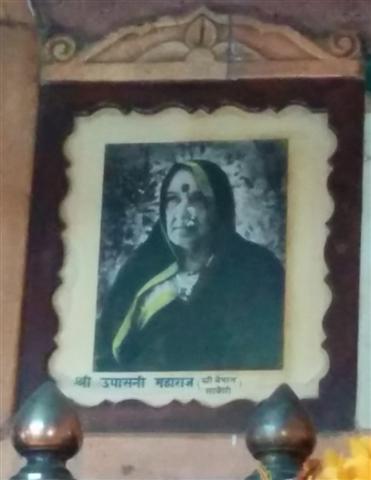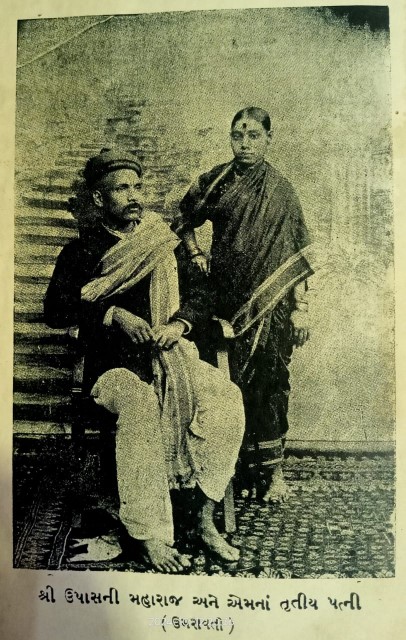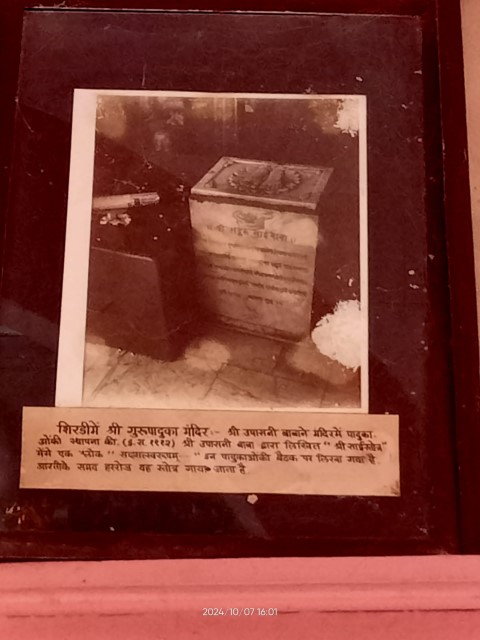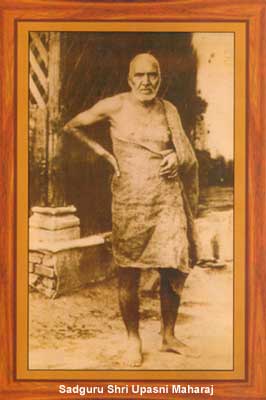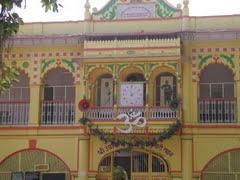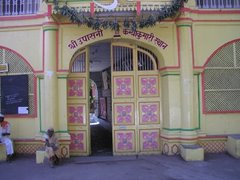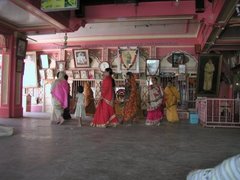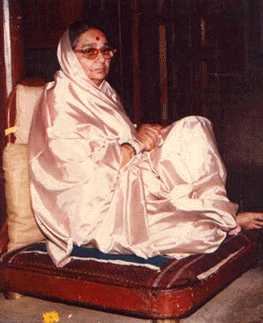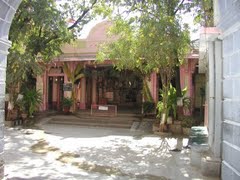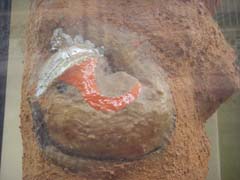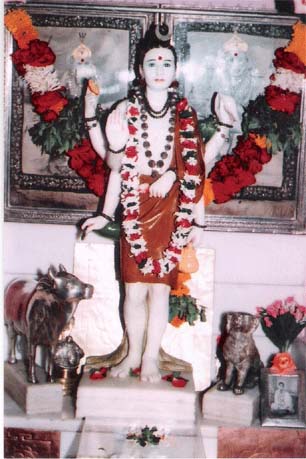|
Upasani Maharaj was born a Hindu in a Brahmin family of priests in the village of Satana, India, in the district of Nasik on May 15 1870. Kashinath Govinda Upasani Sastri was the real name of Upasani Baba.His father's name was Govind Shastri and his mother's, Rukmini.
Govind Shastri - Upasani Baba's father
Upansani's Mother Rukmini His early education was practically nil. He was sent to an elementary school and very early in that period, a merciless master named Gharpure birched him severely. The boy cried and roaring with pain went to the Village Munsif to lodge a complaint. There the matter ended and his education also ended. He could have picked up the rudiments of the Purohit's learning necessary for carrying on the work of the Village Purohit, but Kasinath did not care to do so. On the other hand, he had a strong dislike for any education, and so was treated as a very dull boy and an exception to the family traditions of love of learning. His elder brother, Balakrishna Sastri, was highly advanced in Sanskrit study and became a Professor of Sanskrit in the Fergusson College, Poona, and was an Examiner for Sanskrit in M.A. in the Bombay University. But Kasinath was treated by everyone as good-for-nothing, and yet according to old and senseless customs, his parents insisted upon getting him married in spite of his protests, at the age of 14 (i.e. in 1883) to a girl of 8, who died in a year (1885). He was again married in 1885 to another girl who also died a year later. The home was already bitter; this marriage obligation tied round his neck made it worse. So. he hated home and took to running away from home. At first he returned after a short stay outside. His later ramblings were prolonged.
Balakrishna Shastri - Upasani Baba's Elder Brother In one of his long tours (in 1890). he was attracted by his habit of yoga or control of breath and meditation, and love of solitude, to Boorkhad Hill. There he could see from a great distance that in the midst of a forest, the hill projected from the forest and disclosed a natural cave or cavern. There was luckily a tree near it. As he approached it, he discovered that he could climb up into the cave with the help of the tree growing adjoining it and sending one of its branches into the cave. He thought that this was excellent for his meditation. He sat up in the cave and tried to meditate. At first he thought he would like to see what his starvation (for there was no chance of getting food in the forlorn cave) would end in, and he wished to see death coming and taking him away. This, of course, was absurd. When death came, he might have no power to see death coming even if death had a visible form. He spent days without food or drink, and finally before he became unconscious started namajapa of God, and his body was there in a fixed posture for an unknown period, and, due to lack of food, his muscles and skin were shrunk. He woke up to find that he was still alive, and there was the feeling of thirst. To quench it he could not discover the means. Luckily, the kind heavens poured down rain in a short time, and that rain, coming down the cavern, poured a mass of water into the cave that collected close to him. All his muscles were rigid except those of his right hand, and with this he could reach and pick up the collected water, and he drank up as much as he could. This restored some degree of vigour in him, and he massaged his rigid body. He began again dreaming and he had a vision which was as follows:— "A Hindu and a Muslim standing by his side pulled off his entire skin disclosing thereby his divinely bright body within him. Pointing to that body they said 'Why do you wish to die? We will not let you die! we are behind you and they vanished." He then ventured to move like a lizard on to the branch of the tree which adjoined the cave. And from that branch, he dropped down. He was glad to see that he did not break his limbs by a fall of about 20 feet or so. He moved on slowly on his haunches to an adjoining village where the poor residents were living by collecting fuel from forests and selling it. He passed some time living upon the milk and wild grain supplied by these villagers, and then came back to his home. This stay in Boorkhad cave is still remembered by his devotees who have tried to erect some memorial there of his early yoga practice in the cave. After his return, misfortune still dogged him, and he resumed a rambling life.
Vishnupant Apko Kulkarni - Younger brother of Upasani Baba Sri Upasani Maharaj had bitter experience of life in his ramblings. He went to Poona City where his elder brother was leading a respectable life as Professor of a College. Sri Upasani would not go to his brother's house. He went out begging his food in some nooks and corners, very often being refused any food. This bitter portion of his life may be said to end with his grandfather Gopal Sastri's death in 1891. After that, Kasinath began to realise that he must do something to earn his bread, and so, he went to Sangli and got coached up in Ayurveda and Sanskrit Grammar under Sangli Venkataramanachar (1892-1895). Thus equipped, he went out to Amraoti, and there practised medicine (1896- 1905). He was unlucky at the outset but soon began to prosper. Amongst those who accepted medicines fiom him was G. S. Khaparde, a leading lawyer and the right hand man of Lokamanya Bala Gangadhar Tilak. Sri Kasinath started and conducted for three years (1902-1905) a Medical Marathi monthly (Beshaja Ratnamala) in which he advertised the patent medicines that he manufactured and with his practice and sale of medicines, he collected a small capital for which he wanted good investment. This was about the year 1907 when, in Gwalior, the State was disposing of Malguzari lease estates. One estate of 2,000 acres could be had by merely paying down Rs.600 as advance money and agreeing to pay fixed rents which might be collected from the tenants or from the forest or other produce. So, the doctor invested his money in Malguzari, and went to live on his estate (1906-1908) but found that he had made a huge mistake. The estate had been thrown up by the previous holder because he could not pay the fixed rental instalments as the tenants would not pay, and the forest and other lands would not yield. Not knowing all that, he had taken up the estate, and found it difficult to pay up the dues to the State, whereupon warrants for seizure of his goods were executed by the village officers even at night when his wife was alone. And to harass him, there were plenty of enemies. The tenants defied him to collect the rent, and the village officers, whose co-operation was necessary to collect the rents, withheld their co-operation. So, after a year or two of struggle with adverse circumstances, Kasinath could not get anything there, but lost his health and all that he had and returned home a broken man with broken fortune and ruined health. Soon after, he bethought himself once again of holy pilgrimages, and started with his wife (the 3rd) in April 1910 to Omkareswar Lingam on an island in the middle of a river (Narmada and its Branch Cavery), and there tried to practise Pranayama himself, and his wife was seated at the foot of that huge lingam (called Somanath or Gouri Shankar) with a diameter of about 6 or 7 feet. He fell down unconscious and his wife sprinkled river water, and that restored his consciousness. But his breathing was not restored, and remembering the usual practice of artificial respiration, he began to heave his whole body and uttered groans so as to move the respiratory muscles of his chest slowly and with considerable groaning and effort, he began to breathe. But he felt that his breathing might stop at any moment. He was afraid to strain at stools or to go to sleep, lest during these times the breathing should stop. He tried to get medicine. But the doctors stated that he had got trouble in the course of his yogic practice and they could not furnish him with a cure. Thinking that he should resort to yogis only for a cure, he went (April 1911) to Rahuri where there was a yogi Kulkarni by name. But that yogi, after listening to his account, stated that he was not having any disease at all, that his breathing was one of the a191ccidents of yogic practice, that it would become normal again, in due course, that his yogic condition was far advanced and advised him to go to Sai Baba Hearing the name 'Sai Baba' uttered by the Rahuri yogi, he said, 'Sai Baba must naturally be a Mohamadan, and I am a Sastri's son and grandson, and so bowing to a Muslim is out of the question'. Therefore, Kasinath declined to go. But while staying with that yogi, he was walking in the streets, and he met an old Mohamadan who questioned him about his trouble, and then gave him the advice: 'This trouble is vatha and will be cured by your avoiding cold drink, and drinking water as hot as your mouth can bear'. Dr.Kasinath had no respect for this advice and treated it as worthless, and went away to Jejuri on his way to meet a Hindu yogi Phatak by name at Moregaon. At Jejuri he again sat up for yoga practice under a thick prickly pear bush, and there, after some time, he felt the pangs of thirst. To quench it. he went to a stream and was about to drink its cold water. Suddenly the old man that appeared at Rahuri, 156 miles away, was seen at this stream, and he said,"What! Are you trying to kill yourself? I told you to drink hot water and avoid cold water". So, he went into the village and was taking hot drink only. With that i.e. with what he first thought to be a worthless recipe, health was fairly restored, for he got good sleep which he never had before. Then he went to Narayan Maharaj of Kedgaonbet, Bombay, a famous Datta Upasaka possessed of marvellous powers. When he represented to Narayan Maharaj that he wanted help for health, Narayan Maharaj made him chew betel and nut, and said that he was finely painted inside and outside, and asked him to go away. Kasinath could not make out what he meant. When he went again and asked him, Narayan Maharaj said that there was nothing more for him to do, and so he started back for Satana, and, on the way, called at the Rahuri Yogi's house, and on the insistence of that Rahuri Yogi, went to Shirdi just to pay a brief formal visit to Sai Baba. This was on 27th June 1911. The first interview between Sri Sai Baba and Kasinath is a very interesting study of the personalities of both, and the method of operation of Sai Baba peculiar to each case. After staying a day, Kasinath went to take leave of Baba to go home. Baba said, 'What so soon? When are you returning?' Kasinath protested that it was not easy for him to return, 'Then' Baba said, 'you had better stay. Do not go away'. The alternatives presented to Kasinath were both bitter to him. "What, either to stay on for ever or to go and return in eight days!" and when he was thus puzzled, Sai Baba said, 'Well, go. I shall see what I can do'. This might appear a threat to those who knew Sai Baba's powers. But as Kasinath understood none of his powers, he simply thought permission had been given to him to go, though rather gruffly. He then went away. He was anxious to get back home now that his health had been restored and have a pleasant Grihasthasrama life with his young wife (third wife). But a strange thing happened. He went out a few miles and stayed at a neighbouring village for a bath in the Godavari. Then another day he started and went a short distance, and again was stopped by something attractive. Like this for seven days, he was within a radius of eleven miles, and on the eighth day he was at Kopergaon with the Brahmachari at the Datta Temple on the bank of the river Godavari, i.e., only six miles from Shirdi. That Brahmachari told him to go to Shirdi and be with Sai Baba. Kasinath, however, declined to accept that proposal. As they were talking, a tonga drew up, and the inmates came out. They were asked by the Brahmachari, 'Where are you going?' They said, 'To Shirdi’. Then the Brahmachari said, 'Take this Kasinath with you'. Kasinath said, 'No, I have been there already'. Then the visitors said, 'That is the best reason. We have not been there. We want some one to be with us to guide us'. Kasinath said that he had not taken his meal and he had no carriage fare, and thus pleaded vain excuses. They said, 'We have the carraige fare, and we will give you food'. So, in spite of himself, out of a mere desire to oblige these visitors and to oblige the Brahmachari, he got into the cart which straightway sped on to Shirdi. There they all alighted. They all bowed before Baba. Baba said to Kasinath, "You have come back! How many days is it since you left?' 'This is the eighth day', confessed Kasinath. 'What!' Baba remarked, 'You said you would not come back in eight days'. Then the spell over Kasinath seemed to disappear, and he woke up and said, 'What, Baba, I cannot understand this. I was eager to go home, and I wonder how I did not go back home. This must be all your doing’. Baba said, 'Yes. I have been with you all these eight days dogging your heels'. Then it flashed upon Kasinath that Sai Baba was (always) wielding vast powers over people's mind, that when he could not think of going home, and when the Brahmachari and others were asking him to go to Shirdi, it was all the work of Sai. So, he was under Sai's Akarshana and Sthambhana and that was how he could not think of his home under that spell! He was -aghast at this vast control over minds and bodies of not one but of many. Then he resigned himself to fate as he called it. He thought 'Some vast Power is seizing me. So, I must bend to it’. Then he was staying on, hoping time and again to get leave of Baba to get back. Through Shama he asked for permission. Baba said, 'Let him stay on’. Then Shama asked what he was to do. Baba's answer was, "To do nothing". Kasinath could not understand what he should do remaining there doing nothing. But doing nothing was only the external appearance. "Doing nothing" in Baba's parlance meant being receptive and receiving everything from him. In Baba's Guru parampara, Sishya's work is simply nothing. The entire operation of moulding, remoulding, raising and reaching the top of the highest spiritual experience is the work of the Guru and the Guru alone. His mighty power moulds everything, internal and external, and the result is, the sishya is turned into the likeness of the Guru (Apana Sarika Karitat) and that is what Baba meant by saying, 'Let him remain doing nothing’. Baba asked him to go and live in solitude (as he already loved solitude) at Khandoba Temple, just outside the village, and not mix with people but to remain alone, doing nothing. Kasinath's tendencies could not be so very easily overcome. Dull as he was considered to be as a boy by the superior members of his family, he was a great pandit especially after his studies at Sangli and literary efforts at Amraoti, when compared with the people at Shirdi. His learning, his mastery of Sanskrit and general information were far superior to those of the ordinary pandit. He was anxious to go on either with mantra or with study which alone he understood to be the constituents of real religion. Baba allowed him to indulge in these for a time, but these were not part of Baba's course for his pupil. Studies are hindrances, as they raise the thought in the minds of the pupil that he is learned, that he is something, and that he must understand everything put to him with his intellect and then rise with the help of that intellect and his book learning. These are all egregious mistakes in Baba's course. In Baba's course, the spiritual experience is a sort of chemical extract inherent in and constituting the spiritual body of Baba, the Guru, and is poured into the soul of the sishya which must receptively receive and absorb the same. The entire work is that of the Guru. The sishya must swallow with deep humility, passivity, and receptivity and assimilate the pre-digested food. Kasinath could not understand this, and went on with his studies especially when he met congenial spirits like G S. Khaparde, Chidambaram Pillai and others and later went on telling stories and lecturing. Anyhow Baba had given him directions, and set to work upon him in a number of ways. However anxious Kasinath might be to benefit from Baba's goodwill, absolute surrender of self was not there. Absolute ridding himself of all the contacts with external world was not there and no idea of giving up Grihasta Ashrama. He was still thinking of his own home at Satana, his wife, his mother, and others. He hoped to join them after achieving progress under Baba and enjoying the result of that progress with his family. That was his idea. But that was not Baba's idea. Baba wanted him to be free from all shackles and absolutely independent of all family or other connections. Sai Baba wanted to make him feel that he was entirely dependent upon Sai and Sai alone at least during the period of probation. Hence. Baba suffered him to get into a number of difficulties for the very essentials of livelihood. Food was easy for a time to get, but very soon the food problem became the main problem of his life. At first he had some money, and lived with the help of what he could get with his money. But Baba had strange purposes in asking for dakshinas. Upasani Maharaj had given some dakshinas but retained Rs.10 with him thinking that he could bank upon it and live upon it till he could get further sums. But Sai Baba asked him for dakshina of Rs.10 and deprived him of his bank and reduced him to zero. Then suddenly Kasinath felt he was in mid sir unsupported. That is just what Sai Baba wanted him to feel. That is, the sishya must feel that he has no earthly support barring the Guru. The zero is the first essential for attaining humility and faith and courageous confidence. Zero on earth is the first step to heaven or self-realisation. One should not feel ashamed to beg. One should not have any feeling of fear or shame at all. Baba put Kasinath into the 'Zero' position which became very distressing to him. He had to depend upon doles of grain given to him by some visitors. But seeing his difficulties, the manager of Dixit's Wada and the free (food) hotel run there invited him at the suggestion of Kaka (H. S.) Dixit to take his meals there free. He did so for a time. But the number of enemies that Kasinath had, had grown, especially on account of the marked declarations by Sai Baba favouring him and the unsocial behaviour of Kasinath. He thought highly of himself and would not care to placate or hobnob with the big men of the place, or among the visitors that came there. So, one day, the Manager said to Kasinath, in the presence of several, as he sat at his dinner, 'From tomorrow forward you are not to have your meal here'. Kasinath became indignant. He said, 'Then why have the meal even to-day?' He got up and said, 'I do not want the meal. It is the dependence on the meal that makes us survive, and our position bitter'. So he went away and starved for two or three days. Gradually some relief or other came to him, but still it was already fasting—Upavasa. His name was often played upon, as "Upavasani", that is, the man starving. Diseases attendant upon such starvation, namely, constipation and piles troubled Kasinath and added to his miseries. Sai Baba was aware of every thing and allowed him to go on enduring all these bitter experiences. Many a sishya turns against the Guru and says 'If he is all powerful, if he is taking care of me in so many other matters, why does he not save me from this trouble?' Unfortunately, many a sishya fails to answer this question properly and loses his faith in the Guru or weakens his faith. It was much the same position in Kasinath's case. He could not understand how he was to get on at Shirdi without any funds and without any persons undertaking his feeding, etc. He resolved to fast as much as he could and put up with suffering. Baba's aim was that amidst such suffering he must pick up faith and feel that his Guru was supporting him. This is set out in Baba's parable of how his own Guru treated him. When he met his Guru, he said, his Guru tied a rope to his feet and that rope was tied to a tree, and he was allowed to dangle, head down and legs up, his body being just over a well, not touching the water, but almost touching it. This is the position of a sishya like Kasinath and sishyas like Baba. The allegory of being hung over a well is easy to see through. Samsara is the well. We have heaps of difficulties. We are tied to our position and kept in the midst of these difficulties, The Guru wants to see whether the difficulties strengthen or weaken our faith. In the case of Baba, his Guru after some time returned to Sai's place and untied his rope and asked, 'How have you fared all this time during my absence?' Sai Baba's answer was, 'Exceedingly happily'. That truth was an extraordinary answer for a man whose body was hung up over a well and tied to a tree and left to himself in the above fashion. But Sai Baba's answer showed thai he had perfect faith in his Guru, and that in the midst of all difficulties in Samsara, he never lost his faith. He knew that his Guru would protect him and come and help him at the time chosen by the Guru. The Guru did come at his own fixed time and removed him from trouble. Unfortunately, in the case of others like Kasinath, the result of the trial is not equally good. Kasinath could not understand that these trials were meant to sharpen and strengthen his faith in the Guru. He thought that sorrow was sorrow whatever might be the occasion, and he could not see in sorrow the hand of Baba, who was using this sorrow for a very high purpose. Baba expected Kasinath to develop nishta and saburi and offer these as dakshina to him. Kasinath was slowly developing both nishta and saburi, and when these two were perfect, the seeds of instruction sown in the heart of the pupil would bear fruit. In the case of Upasani Baba, he was brought up under very orthodox parents, and there was abundance of faith in his home. But there was also a certain amount of dependence upon one's own judgement as to the materials necessary for progress - even for spiritual progress. Gopal Sastri was after all a village purohit and for the welfare of people, temporal and spiritual, would administer mantras, tantras, etc. not always resting upon mere prayer with faith. Even yantras, mantras and tantras depend upon faith. So, to some extent, Kasinath was accustomed to regard faith as an essential element in his nature. But to a large extent he was proceeding on rationalistic lines, which also are developed in a purohit's home, could not easily be settled by a short stay of Kasinath with Baba. Kasinath's great difficulty in the matter of faith was the peculiar modus operandi of Sai Baba. Sai Baba on one or two occasions declared everything openly, and Kasinath was lucky in having Sai's plans disclosed to him at the very outset of his contact with Sai Baba. Sai disclosed to him that he (Sai) was the person who cured Kasinath's disease by prescribing a recipe at Rahuri and enforcing the same at Jejuri, that he was intimately interested in him, that their ancestors were intimately connected with each other for thousands of years, and therefore, the obligations between the two were so great that they could not easily be settled by a short stay of Kasinath with Baba. Baba said, 'These accounts will take two or four years to settle'. When Shama asked on behalf of Kasinath 'What account?' Baba said, 'I have to settle the accounts of every one who comes to me'. This was rather inexplicable because Sai Baba was not running a money-lending or pawn-broker's business. Anyhow one thing was clear, that is, that Sai Baba did declare that he was under a very heavy obligation (RINANUBANDHA) arising from contact for decades or centuries towards Kasinath, and that he was determined to do his level best for the uplift of Kasinath. But what the latter was to do for his part was not clear to him at all. Shama asked on behalf of Kasinath 'You ask him to remain here. What is he to do?' Baba's answer was, 'Let him do nothing'. This would appear ludicrous in the eye of any one, to stay in a place doing nothing for four years! Though Kasinath did not leave the place, he could not easily understand what he was to do "doing nothing" for four years. Then the way in which Baba prepared him to rope him on to himself (Baba) was totally unintelligible. Baba seemed to be totally indifferent and not doing anything like an ordinary teacher or Guru. On special occasions, no doubt, he gave some instruction through visions and once or twice orally also when Kasinath met him in the flesh. But these were so few that they were apt to be forgotten, and Kasinath really would fancy nothing was being done towards him by Sai Baba. In point of fact when he met his elder brother, Balakrishna Sastri, probably on 31st December 1911 he told him I do not understand what this Sai Baba is doing to me. It is totally unintelligible. And Balakrishna Sastri also did not understand. Forgetting the glorious future promised for him by Baba, Kasinath believed that he was soon to die at Shirdi in 1912 or 1913. He said to Chidambaram Pillai that he was tortured like a dumb brute; this was the middle of 1912 and 1913. In November, 1912, he told a Samudrik Sastri, Palmist, that his life was miserable and wasted and wished to know if his future would be bad. That palmist evidently knew of Baba's assurances to Kasinath and believed them, and his words of Kasinath's divinity (divinity inferred from body marks) were valued by Kasinath though Baba's earlier assurance of achieving divinity had been undervalued or forgotten. One thing was clear, namely, that he was getting (so far as his physical and mental condition was concerned) from bad to worse. His discomforts were great and his mental peace seemed to be also lost. First when he was suspected to be a political refugee or a C.I.D. Officer, the villagers and the police threatened him, and he had to go to Sai Baba and complain. Baba said, 'Do not mind all that. I will look after you. Everything will be all right.' That trouble ceased after a while. But again other difficulties arose. Baba told Kasinath that he was to remain there for four years and, though he did not like this, he had to put up with it. He had to simply keep quiet at the temple (Vittoba temple as Baba called Khandoba temple), and at the end of four years he would be the recipient of God's full favour and Shama would then come to him and take him out and place him in the open, i.e. as an object of reverence to all people, for he (Upasani) is or would be God or the full recipient of God's favours, which amounted to the same thing. Baba had told him that he need not do anything at all. Kasinath was not able to understand the course sketched out by Baba, and had no ambitions for God-realisation at such cost. He was a total stranger to that place (in fact he felt he was an exile) and appeared to many to be unworthy of the high honour conferred on him by Baba. So some devotees of Baba were jealous and one of them, a Prabhu (from Bombay), asked Baba, 'What, Baba, we have been attending upon you for years, and you seem to be conferring a copper plate grant of all your powers to this stranger, and are we all, therefore, to be neglected? Is it true that you are giving all your powers?' Baba was not to be frightened by any such questions. 'Yes', said Baba, 'I speak only the truth sitting as I do in this Masjid. What I have spoken, I have spoken. I have given everything to this person. Whether he be good or bad, he is my own. I am fully responsible for him, and, as for sasana or a grant, why a copper plate grant? I have given him a Gold plate Grant'. Turning to Kasinath, he said, Think which is better, copper or gold?' Kasinath was too much dazed by the prospect of four gloomy years to be spent at Shirdi, away from his wife and kith and kin at Satana, to give any rational answer. He said, I do not know, Baba'. Baba said, 'See, copper gets corroded and tarnished. Gold does not. Gold remains pure always. You are pure. You are Pure Bhagavan'. In this way, Baba by his declaration of special consideration for Kasinath had caused considerable jealousy amongst some, and yet this did not succeed in making Kasinath place entire reliance on him and feel happy with his lot. There were other sorts of troubles also for Kasinath. He was advised to keep himself to himself as far as possible and spend his time in solitude. But at first this was causing misapprehensions in the minds of some people. For a time in 1911 and 1912 he and G.S. Khaparde and others had study classes for several months, and during that time, Kasinath was a student attending at Khaparde's study classes (of Paramamrita and Panchadasi) and took an active part, reading the text, putting questions and getting clear elucidations from G.S. Khaparde, who generally acted the part of the teacher in those classes. These catered to Kasinath's natural intellectual bent and were highly appreciated by him. But after these were over, the time was dull and Kasinath thought that the best way of his utilising the time was to do mantra japa. As every Sastri does, he also counted his mantra japa. For this purpose he was keeping pebbles to reckon the total number of hundreds of japa he had achieved. On one of these occasions, Baba came and asked what those pebbles were for. When told they were for reckoning the japa, he kicked them aside, and asked, 'Who asked you to do all this? Keep quiet. Do nothing'. Kasinath could not understand how mantra japa was unnecessary, and what he could do by doing nothing or how he could benefit by doing nothing. He was a total stranger to Baba's methods of interior moulding or instruction of the sishya through the soul, not through the intellect, without the utterance of a single word and without meeting him in flesh. There was no study class with Baba, and Baba rarely talked to Kasinath. So there was no formal oral instruction, and what he got was in some strange way, which he realised to be Baba's teaching only very much later. One strange method adopted by Sai Baba in the case of Upasani (for Sai Baba adopted different ways for different persons) was to convey the instruction through vision and pictures. One may wonder what "pictures" could be seen at Shirdi, where there were no cinema houses. We must remember that edification through pictures was a very minor item in Baba's procedure for the main portion of it was concerned with Baba as the powerful dynamo of love, gripping the Sishya's little vessel of love and charging it fully (though slowly and gradually) with all its fullest power. Kasinath was a regular performer of his trikala sandhya, and for the noon sandhya, the orthodox take water in their palms and offering it to the Sun throw it out towards the east. This is called 'Arghya with Gayatri'. On such an occasion, Kasinath held water in both his palms, and the noon day Sun was glittering brightly in the reflection found in the water held in the palms. Kasinath went on gazing at it, and the result can easily be guessed. As medical books describe it, an excessive exposure of the balls and needles found at the end of the optic nerve results in paralysing them and the power to see and discriminate with the help of light is lost by reason of such paralysis. A full description of this is to be found in medical books. Kasinath's experience on that occasion was his first, and he could not understand how seeing the reflection affected him. He lost the power to see anything, and everything appeared dark to him, though it was noon day. Then he began to think that the sun's rays were coming into his head and going out through his eyes: He fancied number of things, because he could not interpret the physiological effects of over-exposure to sunlight and he feared that these symptoms betokened the approach of death. He ran up (thinking that he had some disease) to some friendly or well disposed houses in the village and asked them to cure him of his trouble either by fomentation or by other means. They found fomentation and other processes useless and they believed starvation was the cause and gave him liquid food. He could not gulp it. They thought this stage of his, which may be described as craziness, was Brahmishta Avasta, to which Yogis developing Yoga are exposed, and which he had got by Sai's grace. After the further feeding at Dixit Wada was refused, and he indignantly resolved not to touch food, as food it was that made people fawn, cringe, and become dependent. He fell into a violent rage of Anna Dvesha ailment phobia. Even when friends send him food afterwards, the food looked repulsive in his eyes. It smelt and looked like excreta. If he put a bit into his mouth, he could not gulp it. It stuck in the throat. When it was in his mouth, he fancied he had already eaten it. If by chance he swallowed a bit, he felt his stomach was overloaded. Therefore, all the food that was sent to him was thrown away to dogs, pigs, birds, and other creatures. All this look extremely distressing, and none could guess whether there would be any good out of this. In fact Kasinath also was very much perplexed, and he felt that life was indeed very bitter. He thereafter had occasion to express his real feelings only to those in whom he could confide such as Sri Sai Baba, Dr. Chidambaram Pillai. and Narsobawadi palmist (November 1912). When he reported his condition to Sai Baba, Baba said "I am always with you. You need not fear. The more you suffer now, the happier and more excellent will be your future. You in one scale, and the world in the other. You are going to be an Avadhuta (naked). Hundreds will rush to take your darsan'. This was Baba's prophecy, and it really came true (1920-1935). But at that time, they could not be appreciated by the pupil. One thing was noticeable. In spite of his starvation, his physical frame did not give way. He could still roll stone rollers on the road and do other bits of hard physical labour, and, as for his pulse, Chidambaram Pallai examined it about April 1913, and found it 40 to the minute. By July he found it 20 to the minute. And yet Kasinath was able physically to undertake hard manual labour. This was treated to be Sai Baba's miraculous intervention on his behalf. Yet Kasinath could not get over his bitter feelings. When the dazzling sun robbed him temporarily of eye sight, and made him fancy that the sun's rays were coming out from inside his head through his eyes, he feared as stated already that these were symptoms of coming death. Again in July 1913, he mentioned to H N. Apte, the famous Marathi novelist, that his life was bitter, that he did not expect to live long, and would, therefore, be glad to see his relatives before he died. In consequence of his statement, Apte wrote to Balakrishna Sastri who came and visited him. After that his mother came and visited him. Still, he could not get over the impression that life was extremely bitter, and (as he told his brother) he could not see what was being done with him by Baba in connection with his spiritual attainments. Perhaps the starting of Upasani Maharaja's worship on 18-7-1913 (Guru Poornima) by Baba's orders might be expected to overcome this mentality. But it did not. One effect of his vision and mentality being upset was that he developed a peculiar habit. Suddenly, before him specks of light would float. Circles would be formed, springing up suddenly and expanding in front of him, coming near his body and disappearing. Several of these circles contained edifying visions like cinema pictures, and they suddenly vanished. He gave his own interpretation to some of these visions. Once, heaps of small specks of light were floating before him, and he thought at once that these were paramanus, that is, the primeval atoms of which the Universe is composed. That vision enabled him to understand the physical constitution of the Universe. Again he had another vision, after his long starvation. Suddenly the Earth, the Sky, and the Sun (Trijagat) were revolving round themselves many miles away from him, and he stood outside these three things and watched their revolution. The whirling Cosmos came gradually nearer and nearer to him all the while diminishing in size and finally vanished like a whirlwind at his side or into him. But in fact there was no wind or whirlwind. He wondered where he was, to see the world apart from him and the Universe apart from him. After 15 or 30 minutes, this vision disappeared. Kasinath drew the inference from it that this vision denoted the spiritual truth that all matter is in motion and that a person must get over his Jagat Bhrama, the whirl and illusion of the world, by getting beyond it, that is, by realising himself as not included within it. Therefore, he got the impression that the Universe, being in perpetual revolution and change, is not permanent, that is, not real (Real or Sat is Trikala Atita) (the soul or Spirit etc.); for it appears, exists for a time, and ultimately disappears, that it emanates from him and remerges in him, and that he is really outside and beyond all this seeming Universe. The world is evanescent (Maya) or Maya manomaya and as the body is part of the material world, which is evanescent, the body is not he. This is something like subjective idealism, and is referred to as Jmmodaya in Upasani Leelamrita -the Marathi memoirs of Upasani Baba written under his supervision and guidance. Kasinath Maharaj had a vision one evening. He saw his grandfather Gopal Sastri standing outside Khandoba temple door and extending his arm as though to draw Kasinath's attention. When Kasinath looked at him, Gopal Sastri said, 'Aham, Madan, Gar' twice. Kasinath could not make out anything. Then the grandfather flourished his hand and spoke loudly emphasizing each syllable that he uttered. He said 'Aham......Madan......Gar' and then vanished out of sight. At once the meaning became patent. 'Aham' means Ego or egotism, Ahamkar. 'Madan' means lust or sex urge, Kama and Mamakar; and 'Gar' means, poison. So, the whole phrase 'Aham......Madan......Gar' was the declaration that egotism and lust were poison and ruinous to his spiritual welfare. He noticed how excellent this teaching was and began repeating the words his grandfather uttered, namely, 'Aham......Madan.. ....Gar’ as a very valuable teaching especially for one in his condition, for Kasinath was undoubtedly egotistic and had not overcome lust. Unless he got over both these, his soul would be ruined. So he went on repeating 'Aham...... Madan......Gar' loudly to himself even though some of the onlookers thought that this was a mad prank of his.
Gopal Shastri - Upasani Baba's Grandfather Kasinath Maharaj had from the time of his Omkar or Somnath Yoga practice (about April 1910) his breathing trouble and had thus the picture of sudden death haunting him every minute so as to drive away sleep from him for fear thai sleep might mean death. He could not even strain at stools for then his breath might stop. So sex urge was unsafe or out of the question for such a person. During his Shirdi stay, which followed 14 or 15 months later. Baba took charge of him. Kasinath Maharaj declared openly at Sakori in the presence of this Sri B.V.Narasimha Swamiji and others that his Guru rendered him then and thenceforward physically impotent and mentally free from sex craving. This is a clear proof that Baba was carrying out his undertaking. Kasinath was to keep quiet and the Guru was to take every step necessary, in fact to book him the ticket, put him into the train, and send him to the destination, and all that Kasinath was to do was to keep quiet 'nimitta matram bhava savyasachin',that is, 'Stand merely as a stalking horse'. These words uttered by Lord Krishna to Arjuna applied very well to this Kasinath Arjuna. He had merely to remain there at Shirdi doing nothing, and everything was going to be done and was being done by Sai himself. Baba helped Kasinath to overcome the feeling of difference between male and female in a very extraordinary way. One day Kasinath saw a circle expand before him, and inside it a vision was enacted. He himself was there. Large groups of girls were there aged about 16. Two of them came out, caught hold of him, and tied him to a huge column in the middle of an extensive plain. They would not release him however hard he might beg. At last a couple of girls released him on condition that he should agree to become a woman. He doubted whether it was possible, but as they said it was possible, he agreed. They said they would put bangles on his wrist, which would render him permanently a woman. Then they gathered round him and told him several moral stories which went deep into him. Maharaj said that he frequently remembered those stories and felt that he was a woman, though his body was physiologically that of a man. Maharaj often in his later days at Sakori put on female dress and appeared as a woman. But this is hardly essential for us now. The main point is that it was the training to make him forget his sex, as thereby he became a fit person for persons of both sexes to resort to, i.e. a Samartha Sadguru. If only he had served out four years at Shirdi under Sai as ordered, his history would have been different.
Sai intended that Kasinath should have nothing except unenviable rags and Sai would look, after him. Sai had already said, 'You are going to be an Avadhuta, (naked),' and he did make him naked by making him lose clothes and having nothing to buy things with. But this is not sufficient. In the case of Upasani, his long courses at Satana, at Gwalior, and other places had strengthened the common idea that wealth is the "main chance", an advantage and a necessity. So, in order to get rid of this craving of a poor man for wealth, much spade work had to be done. Baba again helped him through visions. As Kasinath sat up one day, he had the following visions. The first of these may be called Papa Purusha Nirasana. Baba came up to him at some mysterious place and sat up. Baba asked him to come near saying, 'I am going to give you Upadesh'. When Kasinath was trying to approach the Guru, a dark and dirty person behind Kasinath exactly like him, that is, his replica (old Adam) pulled him up and said, "Don't listen to the Guru. But listen to me". Twice this interruption took place. Then Sai got up, seized that dark person behind Kasinath, took him and placed him on a pile of faggots and burnt him. All that time Kasinath was saying 'Baba, it is me whom you are burning, it is me whom you are burning'. After completely burning him out, Baba turned to Kasinath and said, 'Yes. That was you no doubt. But you were in that sin form, namely, Papa rupa. I have destroyed him. You are now free from sin. By our united efforts there are many things to be achieved in the future. How can that be done if sin remains?' Another vision which Kasinath Maharaj had was this. As he was passing along, there was a deep dark pit. A hand came out of that pit as he stood on the brink of it, and tried to pull him down into that dark abyss. Maharaj cried, 'Hands off. Who are you? Why do you drag me? If you do not let me go, I will report to Sai Baba'. At the mention of Sai's name, his feet were released. In that very vision, he learnt that the black abyss and black hand were Hell, that Hell would seize any one who came near, and it was a mistake to come near and tempt Hell. Later in another vision he was offered a lamp, and Baba told him, 'You must accept the lamp. It would light you and protect you everywhere. You will never be obstructed. You will escape obstacles, and will give light to hundreds in the future.' Maharaj accepted the light. Baba told him at one time, 'I will take away half of your head and give you half of my own'. Accordingly, Kasinath had a vision. Some ruffians came and cut his head off, scooped up the brain, ate the contents and ran away. Then in a later vision, Sai Baba took Maharaj to some mysterious place and showed him a heap of silver rupees, 225 feet long. 120 feet, broad, 4 feet high. Over that there was a princely bed with bolsters of lace cloth, and over all this was a richly dressed and gaily ornamented person. Sai Baba asked Kasinath to see that man. Kasinath asked, 'Who is that?' Baba said, 'Have you not recognised yourself? It is you. Your body of sin has gone. That papa purusha has gone. This is your punya purusha'. Then, pointing to all the rupees, vast hoards of rupees, Sai Baba showed him a big room full of rupees and said 'There are hundreds and thousands of such houses filled completely with rupees. All these are ours. You will come to know all this by yourself. Thus, the subconscious mind of Kasinath Maharaj was being impressed by Sai Baba with the feeling that it was cloyed and glutted with ample possession of wealth. The next lesson that Baba taught was through the same picture. Kasinath
was trained in methods of karma and bhakti and though he professed adoption of
Sankara's Advaita, his practice was all on the lines of bhakti and karma adopted
by Ramanujacharya's Visishtadvaita. This is the practice of Uddhava Mutt to
which Upasani's family belonged. So, he was not accustomed to Advaitic
questioning on the lines sketched out in Vivekachudamani or to raise the
question through introspection as to what the Self is by asking oneself 'Who am Sri Upasani Baba was widely regarded as a wonderful saint with vast and miraculous powers that could help individuals and even nations, and that was why Mahatma Gandhi with a view to secure national welfare approached him about 1927. The fame of Sri Upasani Baba was at one time so great (1920-1934) that people found it difficult even to get access to him. About 1930 he visited the house of Sri Sail Govind Banathwalla at Volkeswar, Bombay, and he sat up on an upper storey, and people wanting to take darsan of him had to climb up by one flight of steps and get down by another flight of steps. This procession of darsan by pilgrims went on from 1 p.m. till 9 p.m. Such was the vast mass that wanted to take Upasani's darsan at Bombay. If in a city like Bombay tens of thousands were attracted to him, one may safely assume that throughout Maharashtra, Upasani's fame drew lakhs of people to him, and Sai Baba, as his Guru, was introduced to lakhs of people as the cause and source of Upasani Baba's greatness and powers. "If the chela is so great, how much greater must be the Guru", people said. This truth was flashed across Kasinath's mind for a moment and then it disappeared. Kasinath continued for very many years, that is, till about 1935, to think on purely dualistic lines and realistic lines. The idea of all personalities being one, or losing one's personality in the Absolute by yoga practice, appeared to him to be totally wrong and unwarranted, and it is only after 1935 by Sai's grace, he took to Ashtavakra Gita study and accepted wholeheartedly the doctrine of the Absolute as put forward therein and by Sankara. Sainath himself said to Advaitins, 'Search the Sastras and see whether the Atman is one or many. But at that time during Kasinath's Shirdi stay, this truth made no impression upon Kasinath. These are some of the elements that go to make up Kasinath's new personality which was being evolved out of his personality by Sai's invisible process. Sai gave also some oral and express instructions which were useful to his pupil and were also useful to others. To Kasinath as to most of us this was a very, very, tough lesson that all souls are one and the same, that Iswara or the Guru God was, and is, in all and was and is All. Yet Baba determined to teach, him this lesson. So, even in the first year of his probation, Baba taught him some portion of this truth. Kasinath was cooking his food at Khandoba temple, and naturally wanted to take the food to his Guru Sai Baba, and to get back the same or rather part of it as prasad from him to eat. But while he was cooking his food, a black dog was watching, and even when he took the food towards Sai's Masjid, it followed him part of the way and suddenly disappeared. When first the dog was present and anxiously looking for the food, Upasani with his orthodox ideas thought it would be absurd to give that low creature, a dog, any food before offering it to God and before men ate (for that was against orthodox ideas). So he did not give any food to that dog. But when he went in the hot sun at noon, with his food to Sai Baba, Baba asked him, 'What have you come for?' Kasinath said. To bring you my naivedya', 'Why did you come all the way here in the sun? I was there' Baba said. Kasinath said that there was none but a black dog there. Baba said 'I was that black dog. So, as you refused to give me food there, I am not going to take this food'. So, Upasani returned that day bitterly repenting his orthodox frame of mind refusing to give food first to the dog. Next day, he was determined to avoid that mistake. So, when he was cooking his food, he looked out for the black dog but found no dog. Then, when he was proceeding with his cooking, he noticed that a sickly Sudra was leaning against a wall and watching the cooking. To the orthodox mind of the Brahmin Kasinath, it was drishti dosha and improper for a Sudra to look on when a Brahmin was cooking. So he said, 'Get away', and accordingly, the Sudra left. When that day Kasinath came near Baba with his food, Baba was very angry. He said, 'Yesterday, you did not give me food, and today you told me to go away.' 'Where were you, Baba?' asked Kasinath. Baba said, 'I was leaning against that wall'. 'Could it be you, that sickly Sudra?' Kasinath asked. 'Yes, I am in everything and beyond', said Sai Baba in words reminiscent of Purusha Sukta mantra of the Rig Veda, "Sa Bhumim Visvato Avritva Atyatishtat Dascangulam." "This means. That Purusha (or God) having pervaded all the world, exceeded it, and went ten inches beyond it." That is, Iswara is both immanent and transcendent. This truth came out of Sai Baba's mouth to Upasani. Just as he told other bhaktas that he was in the pig or dog that they fed or failed to feed, similarly he told Upasani that he was in the man or dog that he neglected to feed. The advice given by him was 'See me in all creatures'. 'Me' means Baba. whom one is bound to worship on account of His great powers, good heart, and venerable position — Vide Upasani's words "Aneka ascruta utarkya lila vilasaih samavishkrita iscana bhasvat prabhavam " i.e. Sainatha who reveals his God hood by many, unheard of, and unimaginable miracles, etc. How can you conceive of Baba being in a dog or a sickly Sudra? They have not Baba's powers or nature. This was the great problem for Kasinath as for many others also. But yet, Baba's grace impressed the lesson on him. Though it looks so absurd at the beginning to believe that everything is really God, still by impressing it upon yourself with humility and faith, you can begin to feel that every object is your Sai Baba and that you must treat it with as much reverence, affection and sympathy as you can. Various devotees like Kasinath have been directed by Sai Baba to adopt this process of mentally conceiving Sainath as being inside each creature they meet. For instance, a young man went out at night and under a tree saw an evil spirit, or ghost, and hastily returned. Baba the next day asked him what he saw. The young man answered, 'I saw an evil spirit'. Baba said, 'No, It was I'. The person answered again that he saw an evil spirit. Then Baba said, 'Go to your mother and ask her'. The man went to his mother, and she told him that Baba (being God) is in every creature, evil spirit or good spirit, and, therefore, 'Baba wants you to remember that He is in everything and that you need not fear anything.' Similarly, when Baba passed away from his body in 1918, Lakshmi was praying, 'Baba, should you not show yourself to me?' and came out in the dark from the Mosque. On her way, there was a snake. At once she said, 'Baba, if you come to me in this form of a snake, what am I to do?' In spite of the terrible form of the snake, she was able to picture Baba within the snake and prayed to it. This is the practice commended by Baba even to those who are at the lowest rung of the ladder. Those who are capable of achieving the highest aim find "that Baba's advice or lesson is far more patent and easily achieved by yogic means.Everything is part and parcel of God. The dog, the snake, and everything is a manifestation of that sacred force which you call your God, and, if so realised, it will really react on you like God. Stand still before a snake. Worship it as God, and it will not bite you. Stand before an evil spirit, and say: 'Thou an Brahman'. The evil spirit will not harm you. The very moment you are thinking that everything is God, your spirit is part of God, you cease to be your body and no harm can befall you. This is the most valuable teaching and training that Baba gave under this heading of Cosmic feeling of Godhood. Another great reason for giving prominence to Upasani Baba in the life of
Sai Baba is the indirect service that he has rendered to the SAI cause and
movement. Though the service is indirect, the number of persons reached and
the amount of benefit conferred in respect of the whole movement by it make it
as good as the first service. The indirect service of Upasani Baba is his being the
cause or the occasion of devotees including Shri.B.V.Narasimha Swamiji being drawn to Sai Baba just at the
time when there was the danger of his frittering away his energies in all sorts of
pilgrimages, studies, and lectures and never reaching personal contact with God Sri Upasani Baba when he came to Shirdi in June 1911 came only as a grihasta but in such a broken-down condition and in such a mood as to warrant his giving up that ashrarna and developing into a virakia sanvasi or an avadhuta working entirely as a man of God for the benefit of humanity That is just what Sai Baba intended to make of him. He came as an Artha one suffering from one trouble or another or a number of troubles, and it is such a person that can be made use of for higher religious purposes. Sri Upasani Baba himself acted on this principle at his own Sakori Mutt, and when people came in extreme distress such as recent loss of a husband, he gave the advice, 'Convert this bitter sorrow into something sweet'. The lady to whom this was uttered by Upasani Baba was shocked, but that is the truth of what Upasani Baba did in many cases and what Sai Baba also did in numerous cases. It is all right to help a man out of worldly trouble and get him into worldly happiness wherever that is possible. But where that is not possible, the next best thing is to give up the idea of worldly betterment or at least complete worldly betterment and recognise the fact that human beings are not born merely for perfect worldly enjoyment and comfort, that life has some higher aim even from the individual standpoint, that from the social standpoint a few suffering souls must be made to suffer for the benefit of humanity, that persons must rise in the spiritual scale through suffering and higher perceptions and make of themselves something superhuman, something divine, and that the ego has to be crucified so that the divine may be raised out of it. The divine force will work such wonders not merely from the standpoint of siddhi but also from the standpoint of moral and spiritual improvement of the world. This has been the ideal on which Baba's Guru trained him and Baba himself tried to train several people, one of whom was Sri Upasani Baba. Others who came to Baba were sought to be improved mainly from their own individual standpoint, though incidentally their individual improvement tended to help others in their improvement. But in the case of Upasani, the improvement was clearly stated to be to make a Samartha Sadguru out of him so that he might benefit mankind. A sanyasi should avoid contact with women and should develop himself in seclusion. That is the reason why Sai Baba when welcoming and almost confining Upasani to Shirdi kept him away from his third wife, who was at Satana, 80 miles off, longing to see her husband. Baba did not allow him to go back to Satana, though he was very anxious to go back to his wife and mother or bring his wife to live with him at Shirdi. Baba had prescribed to him the course mentioned in Srimad Bhagavata 11th Skanda :—"streenam stree sanginaam sangam tyaktva durata aimavan, Ksheme Vivikta aaseenas chintayen maamatandritah", i.e. "the self-controlled person should keep away from the company of women and those fond of women, sit in seclusion and ever concentrate on ME (the Lord)." The wife and mother relations are all good, but one must begin to feel that every woman is one's mother or sister. This is the general feeling everywhere amongst saints.
Upasani Maharaj's 3rd wife Amaravati Sri Sai definitely told Sri Upasani
that there was nothing for him to go back to Satana and that he must remain at Such being the notions of Upasani Baba, Sai Baba had much uphill work to change his ideas and see that the natural tendency for the male to consort with the female, seek her company and revel in it, as the main joyous portion of one's life was wiped out in Upasani's case. Sai Baba is the highest power known to us that can effect such a change. It is already evident now the great success he achieved through visions and in other ways. But there seems to be a certain limit to the success achieved in transforming a sadhaka into a perfect siddha. It may be that some sadhakas are like curly hair which however much one may straighten out would again curl up. Anyhow, in the case of Sri Upasani, Sai Baba tried to keep out woman's contact with him as long as he was at Shirdi. Upasani's third wife died. No other marriage connection was then possible. Then what Baba expected was that after four years of novitiate under him at the Khandoba temple were over, Upasani would develop into a perfect Samartha, a Guru-God, for all persons and that Shama would bring him out from his solitude in Khandoba temple to a public place so that all may worship him as the patent perfection of Divinity. But this consummation was somehow not to be. It was prevented in various ways. The solitude itself was oppressive. The older tendencies though being snuffed out could not be snuffed out completely. A little remaining spark is enough to restart a flame and destroy a forest. After three years of novitiate, during which there was daily, hourly, or even perpetual contact, seen and unseen, with Baba, Upasani cut himself away at midnight of 25th July 1914 and went away to Scinde, Nagpur, and Khargpur, many hundreds of miles away. Miles do not form by themselves a hindrance to the operation of a great power like Sai Baba. But the surroundings there are totally different from Shirdi surroundings and act in a totally different and opposite way. The tendency to self-assertion, the development of the ego, and of other unwanted but deep-rooted tendencies would go on apace in all those places and the perpetual contact with Sai Baba would not be available there to check those unfortunate developments. So the result was that what Sai Baba intended was realised only in part and not fully. A tree grew from the seed sown, but it did not shoot up in the way in which such a tree ought to shoot up. On the other hand it had a bend and a bent of its own. Sri Upasani's older tendencies, idiosyncracies and ideas, though modified by what he picked up at Shirdi, were remoulding him and the result was to develop a Upasani Baba working on lines reminiscent of Shirdi but in directions totally different from Sai Baba's. Upasani Baba for a series of years was leading the life of a lonely avadhuta away from his family, and he began to exhibit some powers and was regarded as a notable pupil of Sai Baba. His moral tales like some of the tales of Sai Baba carried great influence with them and made people feel that they were in the presence of a moral power. Some siddhis began to shoot out of him, e.g. mind reading, mind control, clairvoyance, psychic healing etc.. and these added to the respect which people had for a saintly looking avadut (for he was perfectly naked except for a gunny bag covering him). Then his worship grew apace. So long as he observed Sai Baba's directions and example of keeping away from women and wealth and avoidance of storing either women or wealth by his side, his influence and power for good were notably increasing. By about 1927 or 1928 one might see that these reached great heights though signs were not wanting to show that contrary tendencies were beginning to work and to undermine the foundations laid by Sai Baba. In time these contrary tendencies fully developed and wealth (counted in lakhs and taking the shape of loans. 80 acres of land, massive buildings, and hundreds of cattle) was stored up and women were stored up. It does not matter in whose name the wealth was stored up. There was the feeling in Upasani Maharaj and in those surrounding him that he was the owner of this wealth, which is exactly the view of the Government which levied income tax, etc. on him. The noticeable point is that so long as he was scattering away wealth as Sai Baba did as soon as it came, that is, till about 1925 or 1926, his popularity was unbounded. He had no enemies. In the earlier days, like Sai Baba (who had no friends nor foes), Upasani Maharaj also had no friends nor foes, or rather every one was his friend. But as soon as he stopped distributing all the things that came to him and began hoarding or piling them up and investing them, began trouble then i.e. animosities, jealousies, etc. Thereupon began a sense of ownership of properties evidenced by numerous benami transactions and execution of testamentary or other documents and a declaration that in the temple he had built no Harijan should enter. Then the idea also of keeping a band of women next to him as his close associates began to develop. During the novitiate at Shirdi, Sai Baba tried to take away the one wife he had. But Upasani had later on twenty five wives, a regular harem with a castle and an Antahpuram in it. The results are most noticeable. Sai Baba after leaving his fleshy body is not dead but is still taking active interest in the welfare of thousands and is the friend and father of all. Sri Upasani passed away in 1941, and thereafter the general public are not feeling that he is still existing and serviceable to them. Even before he passed away, the antagonism between him and various classes and the way in which he had to figure in courts as witness or as accused or party shattered all chances of his leading a pure Sai Baba sort of life. He went on accumulating the number of his wives, now by one process and now by another, first by marrying people to Krishna images and, when that was stopped by a special Act of the Bombay Legislative Council, next by marrying heaps of women to himself, an act which is now prevented by the Hindu Code or the Anti-Polygamy Act. Thus Sri Upasani's acts even during his life tended to decrease his popularity and strengthen the Divekar agitation. About 1926, Upasani's following or admirers could be counted in tens of thousands. Divekar began his agitation in 1934 and carried on his agitation through Kirloskar magazine and Court proceedings till 1936. Before it was even half way up, the entire tens of thousands evaporated. It was difficult to find even a thousand people enthusiastic over Upasani Baba. People felt ashamed to say that they had anything to do with Upasani Baba. All that became possible only because the great aims and standards set up by Sai Baba of having nothing to do with wealth or women had been abandoned. In the earlier years of the third decade of 20th century, praises of Sri Upasani Baba were sung alike by those of the Sai Sansthan at Shirdi and by others. In the classic Sai Satcharitra of Dabolkar (Hemad Pant) in chapter 44, 122,"Bhakta Sereshta" Upasani (i.e. the eminent devotee) is mentioned as performing at Kasi the annual sraddha ceremony for Sai Baba; further reference is made to his doing pratishta of Baba's Paduka in 1912 at the foot of the Gode Neem tree. Sri Nilakantha in Sai Leela Mask II said in 1924 that Sainath was great because he made a saint of Upasani. People then believed that Sri Upasani was a saint of the type of Sri Ramadas and Sri Sai Baba; and there were powers (siddhas) shooting out of him off and on which justified the hope that in due course he would be in full possession of the innumerable and practically endless armoury of siddhis which were always at the disposal of Sri Sai Baba and which, according to Bhagavata, skanda XI, Chapter XV, any one intensely concentrating upon Iswara can and often does get. Itt may be mentioned here that Sri Upasani Baba himself in his Mahimna Stotra, which is daily recited in the worship of Sai Baba, refers to Sai Baba's divine personality being revealed by the marvellous lilas (i.e. siddhis, etc.) which he performed. "Aneka ascntta alarkia lila vilasaih, Samavishkrita Iscana bhasvat prabhavam" This means, 'Sai Baba whose brilliant divine nature glowed through the innumerable, unheard of, unfathomable miraculous deeds'. This was evidently referring to Sai's leelas of which hundreds or even thousands can be traced now in Sai literature alike as happening during his life time and after he left his body. Here the inference of divinity from the possession of superhuman powers is most natural and even based upon scriptural texts. The Chandogya Upanishad mentions the eight special siddhis which appertain to Godhead and this is stressed in Bhagavata, Skanda XI, Chapter XV. The latter adds that a complete possession of these 8 siddhis belongs only to God, that sants and sadhus have only imperfect or incomplete mastery over them, and that the accomplishment of the remaining siddhis (about 18 in number) may be achieved by ordinary persons who have not reached divinity of nature. In the case of Sri Upasani, stray instances were forthcoming of his ability to read the hearts of others and to control disease or foretell mishap or good fortune etc., in several circumstances. These lent some support to the belief that in due course he would arrive at the full perfection that people noticed in Sri Sai Baba.
Gurusthan - Shirdi and Sai Mahimna Stotra Inscribed on the Pedestal Sri Sai himself once declared to a questioner who asked him, 'Baba, are your powers to die with you or will there be any successor?' (According to Rao Bahadur H. V. Sathe who made this statement to Shri.B.V.Narasimha Swamiji), 'Arre, will there not be some man coming in tatters?’ This was long before 1911. In June 1911 Kasinath Upasani Maharaj came in tatters and Sri Sai Baba fixed him up for four years, novitiate under him to be spent in solitude at Khandoba temple, after which period Baba stated that Sri Upasani would be in full possession of God's powers and that Shama would drag him out of his solitude and place him as an object of worship, as God should be worshipped (by all). Baba even mentioned that he was making a gold plate grant of all his powers to this Upasani Maharaj. Many people, therefore, were hoping and believing that Sri Upasani Maharaj would become a full-blown Samartha Sadguru and take the place of Sai Baba to serve devotees, old and new. But this was impliedly (or even expressly) conditioned by Upasani's stay for four years under the direct control and in perpetual contact with Sai Baba at Shirdi. As fate would have it, or as perhaps Sri Upasani would have it, this condition was not fulfilled. After three years of novitiate, Sri Upasani having cut himself away, the prospect of his attaining full Samarthaship under Baba and continuing his mission, especially from his stay at Shirdi, was shattered. One may ask whether Baba could not mould him when Upasani went to Scinde, Nagpur, Kharagpur or Sakori. No doubt that may be a possibility. But we are not here to discuss possibilities. We have to discuss what actually happened and whether the novitiate continued even after Upasani's cutting himself away from direct and perpetual contact with Sai. As for difficulties of continuing the novitiate, one thing is patent. At Shirdi there was perpetual control and perpetual concentration on Sai preventing one's running away on one's own lines and developing egotism and other allied harmful tendencies. At Scinde, Nagpur, and Khargpur, the scope for developing one's own tendencies and running into one's own and even harmful lines was very great. In fact it was a lapse back again into old lines of thought and one may notice after going through all this vast mass of report of what Sri Upasani said and did at all these places and at Sakori that Sri Upasani had revolted against not merely the control of Sai but also against the line of thought and action pursued by Sai which line and action were no doubt invisible and rather ill perceived by Sri Upasani. Nature tends to recur to old familiar lines and Sri Upasani was recovering his old lines of thought developed from his grandfather's house at Satana, i.e. the lines of thougt of a village purohit considering that the main item in religion is the pursuit of observances, rituals, vows, mantras, yantras, etc. It is these that we find to be predominating in the Upasani literature that is now at our disposal. No doubt Sri Sai's influence also is seen to be intermixed with these writings, sayings, and views. Upasani Baba has been holding the torch as high as he could to draw people away from mere worldliness of a low type, and turn them to God at least for success of temporal ends and to aim as high as their circumstances would permit. But the main stress over and over again in Sri Upasani's lectures and writings is on the accomplishment of the various Purusharthas or goals of life (and notably on saumangalya and success or wealth etc.) through the methods recommended in numerous sastraic works such as japa, tapas, dhyana, dana, vrata etc., on purely conventional lines. No doubt Sri Upasani's original genius is brought out here and there by his departure in method and technique from the old standards. Yet. on the whole, Sri Upasani at Sakori was practically continuing the work of his grandfather Gopala Sastri, an eminent purohit, highly learned in the various sastras and able to administer to the needs of his clients most of whom wanted only success, saumangalya, Lakshmiprasada etc. No doubt in the case of Sri Upasani there were additional powers based upon the inner working by Sri Sai Baba and upon his practice of solitary dhyana. etc., and upon the prestige he acquired as Sai's disciple, worshipped by the pujari of Sai Baba, namely, Bapu Saheb Jog, for a number of years, a fact which would impress most people with the idea that Sai was being continued (as Jog thought) in the personality of Sri Upasani. But any one who looked beneath the surface could easily discover that the main line of thought, action, and being of Sri Sai was clearly different from that of Sri Upasani. Sri Upasani was flying off from Sri Sai at a tangent in the matter of his thoughts and deeds. As stated already two glaring instances would show the marked difference between the two. Whereas Sai never tolerated the piling up of any wealth which could be thought to be his, Sri Upasani (after some years) did exactly the opposite. Whereas Sai Baba had no relations and no women to contact him, Sri Upasani worked exactly in the opposite direction. He was storing up groups of women to live with him; at first a batch of 5 and ultimately a batch of 25 were tacked on to him by ties of marriage. No doubt these marriages were explained by Upasani Baba as emblematic and holy and not as a case of Mormonism or of uxorious cravings of a wealthy householder or ruler. Anyhow these betray serious and glaring differences of views and polices. Sai Baba prevented Sri Upasani from going back to Satana or even have his Satana wife brought to him at Shirdi, as prayed for by Sri Upasani. Upasani's ideas however were exactly opposite to and poles apart from Sal's. Even in 1937, when he made his speeches to admiring people, he mentioned that it was a great good for ardent devotees to donate their girls and women to sants; of course, he, Upasani himself undoubtedly was considered a sant. He has mentioned this times without number later on and his speeches and writings abound with such sentiments. Acting upon these declarations of Upasani, some devotees presented their wives to him and some (rather a large number) gave away their daughters to him in marriage so that they might live with him, and that is how he got such a large number as 25 wives or satis by the end of his career. In an earlier speech, he mentioned that hundreds of women would be offered to him. The rationale of the gift was expounded by him very ingeniously. He expounded a new and revolutionary doctrine that men could achieve their salvation through women. It was Sri Upasani's theory that women by nature were"prarabdha rahita" i.e., free from Karma or sin, whereas men by nature were full of Karma; and women, by avoiding active mingling with society and refusing to undertake responsibilities, would remain totally free from Karma and by their purity, they would raise their husbands and parents to Heaven. This achievement of salvation by marrying kanyas was a favourite doctrine with Upasani and the Kanyasthan with its 25 kanyas wedded to him as satis (sati being the foamy adulterator of a saint) became the standing illustration of his doctrine. The question how these kanyas could achieve the salvation of any one by wedlock, is not easy to comprehend. In the case of Upasani himself, he did not require any wives to lift him to Heaven or Salvation, as he declared that he was God, and in the case of others it is not these kanyas whom they could not wed that could raise them to Heaven. The solution offered by Sri Upasani seems to be this. These kanyas by doing yajnas, yagas, and anushtanas, would accumulate such a heap of merit and constitute such brilliant examples as to induce other women to become like them, and being free from karma and marrying men, they would make the husbands also fit for Heaven by their own freedom from karma. These notions are very hard to comprehend and we are not aware of even a single case in which this ideal has been accomplished, though it is about many years since they were promulgated by Upasani Baba and acted upon by him. This is recorded not to criticise Sri Upasani or his theory or his actions. The above is mentioned with all due reverence to Sri Upasani merely to indicate that he went off at a tangent from the lines or ideals adopted by Sai and that his activities pre-mortem and post-mortem were not such as to justify the hopes once entertained by Sai Baba and others that he would continue Sai's mission and work on Sai's lines. This is not however to condemn Sri Upasani's life or activities or thoughts. He has led a noble life devoted to the cause of religion drawing many thousands of people away from materialism to the path of bhakti and many thousands have been benefited by him and led a religious life. In the matter of development of high powers of endurance and self control, Sri Upasani Maharaj advanced very far. as one more instance of which the following may be cited. In 1914 when he went to Scinde he suffered severely from piles and that necessitated an operation. The Civil surgeon who came to pull out cauterise and stitch the piles would do the same only after administering chloroform to the patient. But Sri Upasani declared that chloroform was unnecessary, and without it he underwent the painful operation calmly and without twitching and disturbing the surgeon, who was consequently so much impressed by Upasani's endurance as to prostrate himself to the Maharaj after the operation was over. Sri Upasani did not develop completely on the lines expected from him during his Shirdi stay and his tutelage under Baba. He devolped on his own lines and built up his own ashram and left traditions and an institution with properties to work on certain lines chalked out by him in his will or other document executed at the closing period of his life. But whatever may be the merits of these need not (we repeat) be discussed here and no further mention of Upasani is called for here. Sri Upasani Baba was one of the bright apostles who by his first instalment of service and his second instalment has rendered great and yeoman service and, therefore, is deserving of the fullest gratitude of all the world, especially of Sai bhaktas. Sri Upasani Baba's grand work of keeping the public drawn to high moral and spiritual levels for about two decades cannot be undone by his failure to reach the acme of perfection sketched for him during his Shirdi novitiate. His achievements were remarkable, indeed so remarkable that persons like Mahatma Gandhi had a right to hope for even great national benefits from him. Unfortunate circumstances, however, prevented the fullest use being made of his faculties. Yet we should never forget the greatness achieved. His services rendered to the Sai movement and to the public should not be ignored or slighted by reason of any defects. Humanity is frail and frailty attaches even to persons who reach great heights like Upasani Baba. That is the one lesson we may draw from the defects noticed above. To go beyond that and either lose respect for him or to treat him and his institutions with disregard, contempt, or hatred would be totally unwarranted and harmful to the persons harbouring such feelings. Sai's own teaching warns us against such a mistake. Upasani Maharaj was the principle teacher of Meher Baba. Meher Baba first met Upasani Maharaj when Upasani was staying in Shirdi with Sai Baba. Upasani moved to Sakori In July 1917 and Meher Baba frequently stayed there as late as October 1922. According to Sai Baba, Upasani Maharaj gave him divine knowledge after he received God-realization In January 1914 at the age of 19 from Hazrat Babajan. After a separation of nearly 20 years, Meher Baba and Upasani Maharaj met for the last time on October 17, 1941 in Dahigaon, a small village in Niphad Taluka in the Nashik District of Maharashtra, just two months before Upasani's death. Upasani Maharaj attained Mahasamadhi in Sakori which is 5 km from Shirdi on 24th December 1941, at the age of 71. Sakori Ashram Upasani Maharaj established Sakori Ashram which is just 5 Km from Shirdi. When Sai Baba dropped His physical form in 1918 Sakori, a small poor village, had already become spiritually rich, with the presence of Upasni Maharaj and a growing fleet of disciples. Maharaj looked after the last rites of Sai Baba as His chief disciple. Maharaj always welcomed hardships. Once in 1921 He locked Himself inside a small bamboo cage. The cage was too small for such a stout person like Maharaj and He was most cramped inside. He said He suffered for the release of His disciples, and was standing as a surety in the divine court for their release. Over thirteen months He confined Himself in that small cage, practically fulfilling all His daily needs from there. The disciples performed His "Arti" and listened to His discourses from within the cage. At last on 31st January 1924, Maharaj released Himself from the cage, and stepped out of it to greet a small child named Godavari.
In 1941 Sati Godavari Mataji assumed the mantle of her Guru Shri Upasani Baba Maharaj with the strength, simplicity and dignity of a realized being. When she ascended the ‘Gadi’ of spiritual eminence, Mataji was only 26 years old. In the freshness of youth, Mataji had a rare and ethereal beauty of face and form. Today, though she looks deceptively frail and simple, there is a quiet radiance and strength, the strength and radiance of immaculate purity stored up in her. The life eternal flows through her spirit, mind and body, cleansing healing and restoring all those look up to her as the manifestation of Shakti. Soft spoken and gentle, with nothing spectacular about her personality and preaching, Mataji nevertheless encloses in her frail form a dynamic fulfillment of God as Mother.
Godavari Mataji Chintamani Vinayak
Shri Ek Mukhi Dattatreya Once the queen of the princely state of Gwalior during Shinde dynasty, came for Shri Upasani Baba’s Darshan. She shared with Shri Baba whatever her wish was. She stayed at Sakori for about a month in the company of Shri Baba. She returned after her wishes came true by the blessings of Shri Baba. Shri Baba initiated her to build a temple of "Shri Ek Mukhi Dattatreya" around year 1925. Mr. Valimbe was the chief architect and civil engineer working on the construction of the temple. He worked under the guidance of Shri Baba and completed the construction of this temple in 1928. The temple initially only had the photo frames of Shri Sai Baba and Shri Upasani Baba and the "Padukas" (footprints) of Shri Saibaba. Shri Upasani Baba stood on the same "Padukas" himself and then also he made Shri Godavari Mataji stand on the same "Padukas" when she still was a small girl. So these "Padukas" have a very special significance.
As you enter the temple, first idol that you see is of Shri Hanuman. This was the same idol close to which Shri Baba stayed in a hut for few days when he first came to Sakori. Idol of Shri Ek Mukhi Datta which visitors now see was specially sculpted by a famous sculptor from Jaipur in Sakori itself under the supervision of Shri Upasani baba himself. When Shri Godavari Mataji was watering plants, Shri Upasani Baba called her and ordered her to pose for a photograph. Shri Baba directed the sculptor to take the photograph and directed to carve the idol exactly as per the photograph. This idol of "Ek Mukhi Datta" has the face of Shri Godavari Mataji, dress is of that of the jute cloth as Shri Upasani Baba use to wear it. Since Shri Saibaba is considered the reincarnation of Lord Vishu, to symbolize Shri Saibaba, the idol has the four hands equipped with the symbols like "Shankha" (sea shell), "Chakra" (round blade) , "Gada" (special traditional weapon ) and "Padma" (lotus). So this idol of Shri Datta has a very special significance and unique importance as it symbolizes the unity of Shri Saibaba, Shri Upasani Baba and Shri Godavari Mataji, all the three great icons in this spiritual lineage. This idol was established on "Paush Shuddha Ashtami" (8th day in the first half of the month of "Paush" as per Hindu calendar) in year 1943. Since that day, the birth anniversary of Shri Godavari Mataji and Shri Datta is celebrated on the same day. Both Shri Upasani Baba and Shri Godavari Mataji has a special affection for this temple. They always used to suggest to do any "Satkarma" ( pious activities) in that temple. There used to be a non-stop ritual of the "namasmaran" (chanting the holy name of lord) 24 hours. So the temple used to be always open. However, now temple closes at night. All the rituals in the Sthan take place first in the Datta Mandir. "Kakad Arti" (first "Arti" of the day very early in the morning), "Madhyanna Arti" ("Arti" at noon), "Shejarti" (last "Arti" of the day late at night), takes first in Datta Mandir and then in "Zopdi". Construction of the temple is done very beautifully with the historical architecture. When Lord Sun is transitioning during in the month of March-April through the Zodiacs of "Kumbha" (Sagittarius) and "Meen"(Pisces) as well as during the month of September-October when transitioning through the Zodiacs of "Simha"(Leo) and "Kanya" (Virgo), that is the only time when the rays of Sun directly fall on the face of Shri Ek Mukhi Datta’s idol. At that time, it’s a beautiful experience to see Shri Datta’s idol beaming with the bright shine on the face. Truly, this idol is very beautiful and spiritually enchanting. The people in Sakori perform, with utmost zeal, the activities like "Sai Charitra Parayan" ( recitation of the biography of Shri Saibaba), "Shri Dyaneshwari Parayan" (recitation of the holy book of "Shri Dyaneshwari"), "Shri Gurucharitra Parayan" (recitation of the biography of "Shri Dattatreya") around "Datta Jayanti" and " Shri Hari Naam Saptaha" (literally meaning chanting the name of the Lord non-stop for a week) in the temple. On the day of "Datta Jayanti" ( celebration of the birth anniversary of Shri Datta) celebrations include "Maha Puja" (literally meaning extended prayers), "Shri Guru Geeta Pathan" (literally meaning the recitation of the holy book of "Shri Guru Geeta"),"Shri Audumbar Pujan" ( literally meaning the prayers towards the "Audumber" tree), "Shri Go Pujan" (literally meaning offering prayers to Cow) and "Shri Shwan Pujan" (literally meaning offering prayers to Dog) and concluded by the " Kirtan" and " Shri Datta Janma" (literally symbolizing the birth of Lord Shri Datta). (Note: All this prayers to the tree, dog, cow are offered as these things are considered closest to Lord Shri Datta and so considered very pious). Next day on the occasion of "Shri Datta Jayanti" big program of "Shri Datta Prasad" takes place during which the food is donated in huge quantities. When devotees look at the photo frames of Shri Upasani Baba and Shri Godavari Mataji hung on the wall of the temple, devotees go back in time of Shri Upasani Baba and Shri Godavari Mataji and experience their grace. In the vicinity of Shri Datta temple, there are other temples of "Shri Ganapati", "Shri Shanidev" (Lord Saturn), "Shri Khandoba" temple. In the temple of Lord "Shri Shankar" , the temples of "Vetal" (considered as controller of evil), "Mahamari" (considered as controller of diseases), and "Lord of Plague" (the disease was considered the evil force in olden days) are also established. Once when Sakori was affected by the Plague epidemic, Shri Upasani Baba personified the evil force of the disease and gave them the respectful treatment by giving them the status of the lords so that the epidemic does not cause the huge loss and established their temples in Sakori. Similary, during the epidemic, Shri Upasani Baba offered prayer to a big brass bell and asked the people to ring the bell. He also gave a blessings and assured the villagers of Sakori that there would not be Plague or any such epidemic in the area where the bell would be heard. And in really there was no epidemic in Sakori after than incidence. There is a procession takes place every Thursday from Shri Datta temple to "Zopdi", on some special occasions also include the decorated chariots. Shri Datta Mandir is a unique place compared to the other places in the state of Maharashtra and believed that Lord Shri Datta fulfills all the wishes of the devotees. This temple has very special place in the hearts of devotees of Shri Upasani Kanyakumari Sthan. "Sakori Ashram is the only place in the world where you can find a Dattatreya Idol with singleface unlike other places where you will find Dattatreya idol with 3 faces". Sakori ashram is also the only place where poojas, Homas are performed by Ladies which is not the practice in other parts of the world. (Source: Life of Sai Baba, Volume II by Late Shri.B.V.Narasimha Swamiji. Photo Courtesy: J.Subramanya, Bangalore and Shri.Jignesh C.Rajput, Surat) |

